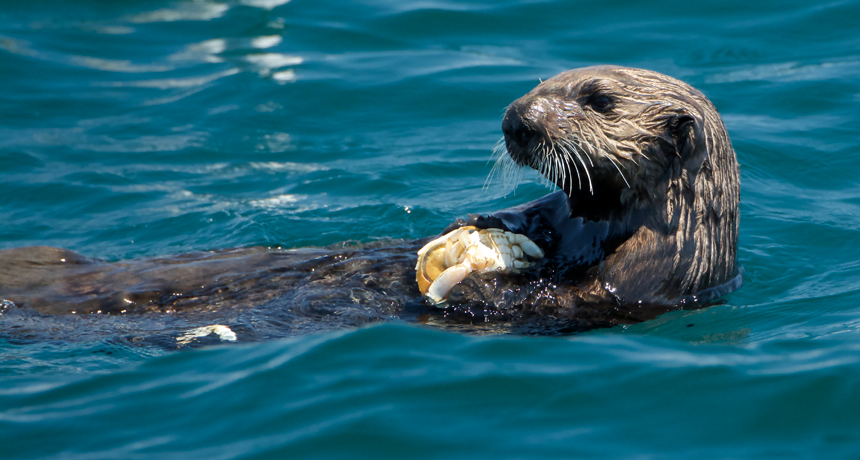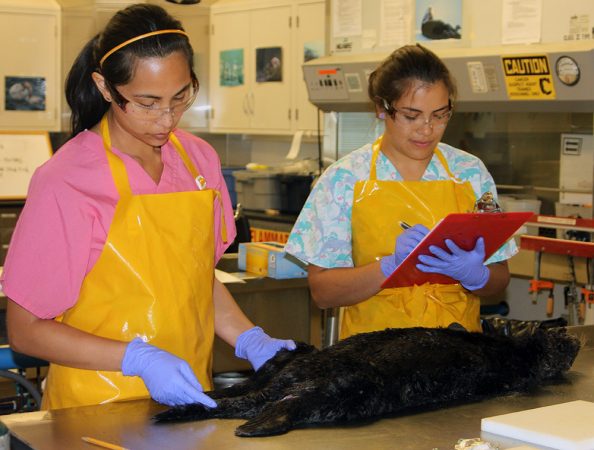Explainer: People can sicken animals
Wildlife can sometimes become infected with germs shed by people

Germs can travel from people and other animals on land into the ocean, making creatures that live there, such as sea otters, sick.
Wade Tregaskis/Flickr (CC BY-NC 2.0)
Normally, doctors worry about how human illness will spread between people. But germs shed by people or their pets can sometimes sicken wildlife, too. And sometimes those germs may hit wild animals as hard — or harder — than they do people.
This is something that Melissa Miller has been studying for the California Department of Fish and Wildlife in Santa Cruz. As a veterinary pathologist, she studies animals to figure out what has sickened or killed them. She and her coworkers think of microbes as biological pollutants. Human or animal feces — poop — is usually the source of these germs that can wash into rivers and the ocean.
Natural wetlands can help slow the flow of polluted water. This gives beneficial bacteria in stream water the time they need to break down pollutants. But people have been converting wetlands to farms and towns in many areas. Now pipes and culverts move water quickly through what used to be slowly draining wetlands. The result, says Miller: Germs that typically live in land animals and people may end up sickening ocean mammals. These may include sea otters, sea lions and whales.

In the past few years, Miller and other researchers have discovered dead sea otters. Many were infected with a microbe called Toxoplasma gondii. This germ can cause nerve damage (including blindness) and retardation in people. It can cause deadly brain damage in otters. Miller and her coworkers now regularly examine the brains of dead California sea otters for signs of this infection, such as swelling and scarring.
Feces of infected land animals — especially cats — can spread the microbe. Rains can wash those feces and the germs they harbor into the ocean. Clams, mussels, crabs and other filter-feeding animals can then ingest the germs. Animals that eat those filter feeders can pick up the germs. “We think that is a big method by which sea otters are getting exposed,” explains Miller.
Sea otters can tell us a lot about the health of the environment, Miller says. One reason: These animals eat a quarter of their weight in food every day. She likens that to a 160 pound person eating 40 pounds of hamburgers every day. Their large appetites and their living close to shorelines make sea otters particularly vulnerable to pollutants that wash off of land. “What the otters are trying to teach us is that as much as we think [pollution] is going to go away, it actually just gets sent downstream and comes back to haunt us,” says Miller.
To help reduce sickness in wildlife — such as sea otters — keep pet cats indoors. In addition, seal the wastes from litter boxes into bags before putting them in the trash. Towns near coastlines should also focus on preserving some natural areas as habitat for wildlife — and as a way to boost the breakdown of pollutants.
POWER WORDS
appetite: A desire to eat or drink, often because of hunger.
bacteria: (singular: bacterium) Single-celled organisms. These dwell nearly everywhere on Earth, from the bottom of the sea to inside other living organisms (such as plants and animals). Bacteria are one of the three domains of life on Earth.
downstream: Further on in the direction in which a stream is flowing or the path at which stream water will flow in its trek to towards the oceans.
environment: The sum of all of the things that exist around some organism or the process and the condition those things create. Environment may refer to the weather and ecosystem in which some animal lives, or, perhaps, the temperature and humidity (or even the placement of things in the vicinity of an item of interest).
feces: A body’s solid waste, made up of undigested food, bacteria and water. The feces of larger animals are sometimes also called dung.
filter: (n.) Something that allows some materials to pass through but not others, based on their size or some other feature. (v.) The process of screening some things out on the basis of traits such as size, density, electric charge.
filter feeder: A water-dwelling animal that collects its nutrients or prey by filtering them out of the water. Some of the best known examples are bivalves, such as clams and mussels. But some whales use long plates of baleen to essentially do the same thing. They suck in water and then use their filtering structures to catch and retain edible materials that had been in the water.
focus: (in physics) The point at which rays (of light or heat for example) converge sometimes with the aid of a lens. (In vision, verb, “to focus”) The action a person’s eyes take to adapt to light and distance, enabling them to see objects clearly. (in behavior) To look or concentrate intently on some particular point or thing.
germ: Any one-celled microorganism, such as a bacterium or fungal species, or a virus particle. Some germs cause disease. Others can promote the health of more complex organisms, including birds and mammals. The health effects of most germs, however, remain unknown.
habitat: The area or natural environment in which an animal or plant normally lives, such as a desert, coral reef or freshwater lake. A habitat can be home to thousands of different species.
infection: A disease that can spread from one organism to another. It’s usually caused by some type of microbe.
ingest: (n. ingestion) To eat or deliberately bring nutrients into the body by mouth for digestion in the gut.
litter: Material that lies around in the open, having been discarded or left to fall where it may. (in biology) Decaying leaves and other plant matter on the surface of a forest floor. (in zoology) A group of young animals born at the same time to the same mother.
mammal: A warm-blooded animal distinguished by the possession of hair or fur, the secretion of milk by females for feeding their young, and (typically) the bearing of live young.
marine: Having to do with the ocean world or environment.
marine mammal: Any of many types of mammals that spend most of its life in the ocean environment. These include whales and dolphins, walruses and sea lions, seals and sea otters, manatees and dugongs — even polar bears.
microbe: Short for microorganism. A living thing that is too small to see with the unaided eye, including bacteria, some fungi and many other organisms such as amoebas. Most consist of a single cell.
pathologist: Someone who studies disease and how it affects people or other infected organisms.
pollutant: A substance that taints something — such as the air, water, our bodies or products. Some pollutants are chemicals, such as pesticides. Others may be radiation, including excess heat or light. Even weeds and other invasive species can be considered a type of biological pollution.
sea: An ocean (or region that is part of an ocean). Unlike lakes and streams, seawater — or ocean water — is salty.
sea otter: A member of the weasel family, sea otters have the densest fur known among animals. That helps keep them warm in frigid waters, because these marine mammals don’t produce blubber — a thick layer of fat — as do seals and walruses.
veterinary: Having to do with animal medicine or health care.
waste: Any materials that are left over from biological or other systems that have no value, so they can be disposed of as trash or recycled for some new use.
wetland: As the name implies, this is a low-lying area of land either soaked or covered with water much of the year. It hosts plants and animals adapted to live in, on or near water.
whale: A common, but fairly imprecise, term for a class of large mammals that lives in the ocean. This group includes dolphins and porpoises.







